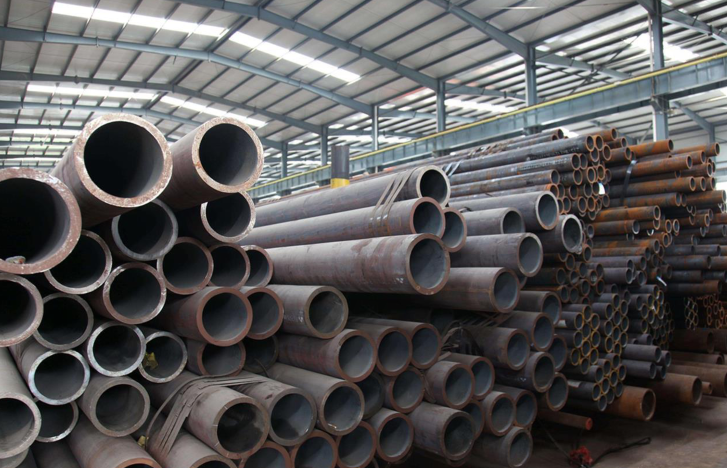
Seamless Steel Pipe Implementation Standards and Thickness Tolerances
The implementation standards of seamless steel pipes mainly include international standards and national standards.
International standards mainly include the following:
1. ASTM A53/A53M standard
ASTM A53/A53M Seamless Steel Pipe Standard: This standard applies to seamless and welded steel pipes used for conveying water, gas and other non-pressure applications. The standard stipulates the size, chemical composition, mechanical properties and other requirements of seamless steel pipes.

2. ASTM A106/A106M standard
ASTM A106/A106M seamless carbon steel pipe standard: This standard is applicable to seamless carbon steel pipes in high temperature and high pressure environments for transporting water, gas, oil and other fluids. The standard stipulates the chemical composition, mechanical properties, dimensions and other requirements for seamless steel pipes.
3. DIN 2391-1 standard
DIN 2391-1 Seamless precision steel tube standard: This standard is suitable for the manufacture of precision seamless steel tubes for use in the mechanical and automotive engineering fields. The standard stipulates the size, chemical composition, mechanical properties and other requirements of seamless steel pipes.
4. DIN 1629 standard
German standard for seamless stainless steel and carbon steel pipes for general purposes.
5. EN 10210-1 standard
EN 10210-1 is a European standard for steel coils and heating tubes used in the production of steel air heat exchangers and boilers in areas such as machining, structural engineering, excavation and mining. This standard specifies the design and specifications based on hot-dip galvanized pipes.
6. JIS G3454 standard
JIS G3454 is a Japanese industrial standard for low-temperature welded and seamless steel pipes for transporting water, oil and gas. The chemical composition, mechanical properties and other physical parameters specified in the standard are restricted accordingly.
7. GB8162-2008 standard
GB8162-2008 is a national standard in China, applicable to pipe materials that are not corrosion-resistant, not high temperature, not high pressure and used in general mechanical structures. This standard divides steel pipes into 10 numbers. The ratio of the inner diameter and wall thickness of the steel pipe is ≥6%, and the larger number must be less than 5% of the diameter.
GB8163 "Seamless steel pipe for fluid transportation"
GB/T9711 "Technical Delivery Conditions for Steel Pipes for Petroleum and Natural Gas Industry"
GB6479 "High-pressure seamless steel pipe for fertilizer equipment"
GB9948 "Seamless steel pipe for petroleum cracking"
GB3087 "Seamless steel pipes for low and medium pressure boilers"
GB/T5310 "Seamless steel pipes for high-pressure boilers"
National standards (China) mainly include the following:
1. GB/T 8163-2008 Standard for seamless steel pipes for liquid transportation: This standard applies to seamless steel pipes for transporting oil, natural gas and other liquids. The standard stipulates the chemical composition, mechanical properties, dimensions and other requirements for seamless steel pipes.
In addition to implementation standards, the allowable thickness deviation of seamless steel pipes is also an important factor to consider. According to different standards and requirements, the allowable deviation of thickness also varies.
The allowable deviations of the outer diameter and wall thickness of seamless steel pipes of different standards are not the same. In recent years, the proportion of seamless steel pipes used in our country has increased. Due to its wide range of uses, higher requirements have been placed on its quality. requirements, among which the outer diameter and wall thickness deviation of seamless steel pipes are one of the important indicators of its quality. Wall thickness deviation will directly affect the use of seamless steel pipes.
During the production process, since the actual size is difficult to meet the nominal size requirements, that is, it is often larger or smaller than the nominal size, the standard stipulates that a difference between the actual size and the nominal size is allowed. A positive difference is called a positive deviation, and a negative difference is called a negative deviation.
Taking international standards as an example, according to the allowable thickness deviation specified in the ASTM A53/A53M seamless steel pipe standard, for seamless steel pipes with a wall thickness less than and equal to 0.219 inches (5.56mm), the allowable upper deviation does not exceed 0.014 inches (0.36mm). The allowable lower deviation does not exceed 0.005 inches (0.13mm). When the pipe wall thickness is greater than 0.219 inches (5.56mm), the allowable thickness deviation is plus or minus 12.5% of the pipe wall thickness.
The wall thickness of seamless steel pipes cannot be the same everywhere. There is an objective phenomenon of uneven wall thickness in its cross section and longitudinal pipe body, that is, uneven wall thickness. In order to control this unevenness, let’s give an example respectively. For example, when the outer diameter of the seamless steel pipe of the national standard GB/T8162 is greater than 50 mm, the allowable deviation of the outer diameter is plus or minus 1%. The outer diameter of the seamless steel pipe is generally For example, for a seamless steel pipe with an outer diameter of 60 mm, the allowable deviation of the outer diameter is plus or minus 0.06 mm, which is considered qualified. The allowable deviation of wall thickness is plus or minus 12.5%. If the wall thickness is 4 mm, the allowable deviation range is 4*12.5%=0.5 mm.
For example, ASTM A53 standard seamless steel pipe, when the outer diameter is greater than 48.3 mm, the allowable deviation of the outer diameter is plus or minus 0.4 mm-0.79 mm, and the allowable deviation of the wall thickness is plus or minus 12.5%.
The implementation standards and thickness tolerances of seamless steel pipes are important basis for ensuring the quality and safety of seamless steel pipes. Different implementation standards and standard requirements have clear regulations on the size, chemical composition, mechanical properties and thickness allowable deviations of seamless steel pipes. When producing and using seamless steel pipes, it is necessary to strictly follow the corresponding standards to ensure the quality and reliability of seamless steel pipes.


